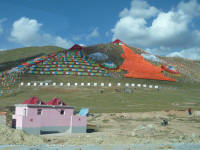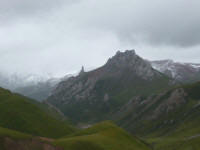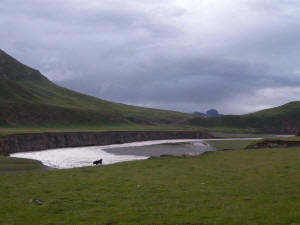








Sichuan and Qinghai: Kham and Amdo
to Yunnan's Southeast
Yunnan's Northwest
back to main Archive page
Kham and Amdo, the southeastern and northeastern part
of the Tibetan world, offer a more pure Tibet than the area around Lhasa
these days. They are spread out over the Chinese provinces of Yunnan,
Sichuan, Gansu, Qinghai and the Tibet Autonomous Region.
Unlike in Central Tibet, there is no big influx of
Han Chinese, and there are very few tourists - western nor Chinese.
Scenery is diverse and very beautiful, with deep and steep forested
valley's, imposing rockpeaks, snowy mountains,
undulating grasslands with yaks and nomads or yellow fields of barley.
Monasteries mostly belong to the Kagyu and Sakya sects, yet another
difference with Central Tibet where the Geluk (Yellow Hat) sect is
predominant.
Sichuan: out of the way monasteries
Major towns along the two main Chengdu-Lhasa roads
are Kangding, Litang, Garze, Dege. Some of the out of the way
monasteries are Pelyul (Ch. Baiyu), Katok (Ch. Gatuo), Sertar (Ch. Seda).
Fascinating! So is Dzogchen (Ch. Zhuqing) with its monastic retreat and
mountain backdrop and a great village rush hour early morning.
Qinghai: sources of the Yellow River, Yangtze and
Mekong
Asia’s three main rivers all originate on the Tibetan
plateau in Qinghai province. The source of the Yellow River is marked by
the ‘Bull Head Marker’ 70 kilometers west of Maduo county town. Its
location on a hill at 4.610 meters between Ngoring Lake and Kyaring Lake
is spectacular, but in fact the Yellow River’s source is 250 kilometers
more to the west, much harder to access. (Some scientist opt for the
head of the Kari Qu tributary to the southwest as the Yellow River’s
real source.)
Sources for the Yangtze are the head of the Dam Chu
below the Tanggula Mountains and the head of the Tuotuo He at
Geladandong west of the Golmud to Lhasa railway. These Yangtze sources
are still on my wish list.
As to the Mekong, I believe I have discovered its real source, see my blog and my article.
Yushu – Xining routes
Yushu was completely destroyed by
a 2010 earthquake. It has since been rebuilt, but its original soul and
character haven’t returned.
There is a direct road to Xining (G214), but a great
alternative routes pass through Darlag (Ch. Dari) and Machen (Ch. Maqing)
more to the east. And to the west is a back route crossing the Yangtze –
Yellow River divide on a great high pass.
